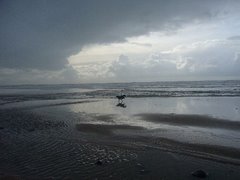
The War Dog Memorial, " Always Faithful.", located on Guam, honours the Dobermans that served with the Marines in 1944 and played a crucial role in recapturing the island.
Less than twenty-four hours after the attack on Pearl Harbor, the Japanese invaded Guam, a small Pacific island and an American possession. For two and a half years, the brave people of Guam endured a horrible occupation.
On 21st July 1944, the Americans struck back and secured the island. American Marine, Army, and Navy casualties exceeded 7,000. An estimated 18,500 Japanese were killed, and another 8,000 Japanese remained hidden in the jungle refusing to surrender.
Among the dead were 25 dogs, specially trained by the U.S. Marines to search out the enemy hiding in the bush, detect mines and booby traps, alert troops in foxholes at night to approaching Japanese, and to carry messages, ammunition and medical supplies. They were buried in a small section of the Marine Cemetery, in a rice paddy on the landing beach at Asan that became known as the War Dog Cemetery.
Interestingly enough, most of the young Marines were assigned to the war dog program only by a twist of fate. Some had never owned a dog in their lives, and some were even afraid of them. But trained as dog handlers, they were expected to scout far forward of US lines, in treacherous jungle terrain, searching for Japanese soldiers hidden in caves or impenetrable thickets. Under these circumstances, the rifles we carried were often useless; a handler's most reliable weapons were his dog's highly developed senses of smell and hearing, which could alert him far in advance of an enemy ambush or attack, or the presence of a deadly mine, so he could warn in turn the Marines who followed behind at a safer distance. It was one of the most dangerous jobs in World War II, and more dogs were employed by the 2nd and 3rd Platoons on Guam than in all of the other battles in the Pacific.
In these battles, as in their training, the men learned to depend on their dogs and to trust their dogs' instincts with their lives. William W. Putney says that when he returned home from overseas, he found that rather than spend the time and expense to detrain the dogs, the military had begun to destroy them. The dogs, primarily Doberman Pinschers and German Shepherds, had been recruited from the civilian population with the promise that they be returned, intact, when the war ended. Army and political officials argued that these dogs suffered from the "junkyard dog" syndrome ie: they were killers. Putney thought they were wrong and lobbied for the right to detrain these dogs and won. The program of de-indoctrination was overwhelmingly successful: out of the 549 dogs that returned from the war, only 4 could not be detrained and returned to civilian life. Household pets once, the dogs became household pets again. In many cases, in fact, because the original civilian owners were unable or unwilling to take the dogs back, the dogs went home with the handlers that they had served so well during the war.
William Putney enlisted in the Marines in 1943 at the age of 23 in search of military glory. Instead, Putney, a licensed veterinarian, was relegated to the Dog Corps.
Putney became the Commanding Officer of the 3rd War Dog Platoon, and later the chief veterinarian and C.O. of the War Dog Training School at Camp Lejeune, North Carolina.
His book, Always Faithful, is the story of the dogs that fought in Guam and across the islands of the Pacific, a celebration of the four-legged soldiers that Putney both commanded and followed. It is a tale of immense courage, but also of incredible sacrifice.
Less than twenty-four hours after the attack on Pearl Harbor, the Japanese invaded Guam, a small Pacific island and an American possession. For two and a half years, the brave people of Guam endured a horrible occupation.
On 21st July 1944, the Americans struck back and secured the island. American Marine, Army, and Navy casualties exceeded 7,000. An estimated 18,500 Japanese were killed, and another 8,000 Japanese remained hidden in the jungle refusing to surrender.
Among the dead were 25 dogs, specially trained by the U.S. Marines to search out the enemy hiding in the bush, detect mines and booby traps, alert troops in foxholes at night to approaching Japanese, and to carry messages, ammunition and medical supplies. They were buried in a small section of the Marine Cemetery, in a rice paddy on the landing beach at Asan that became known as the War Dog Cemetery.
Interestingly enough, most of the young Marines were assigned to the war dog program only by a twist of fate. Some had never owned a dog in their lives, and some were even afraid of them. But trained as dog handlers, they were expected to scout far forward of US lines, in treacherous jungle terrain, searching for Japanese soldiers hidden in caves or impenetrable thickets. Under these circumstances, the rifles we carried were often useless; a handler's most reliable weapons were his dog's highly developed senses of smell and hearing, which could alert him far in advance of an enemy ambush or attack, or the presence of a deadly mine, so he could warn in turn the Marines who followed behind at a safer distance. It was one of the most dangerous jobs in World War II, and more dogs were employed by the 2nd and 3rd Platoons on Guam than in all of the other battles in the Pacific.
In these battles, as in their training, the men learned to depend on their dogs and to trust their dogs' instincts with their lives. William W. Putney says that when he returned home from overseas, he found that rather than spend the time and expense to detrain the dogs, the military had begun to destroy them. The dogs, primarily Doberman Pinschers and German Shepherds, had been recruited from the civilian population with the promise that they be returned, intact, when the war ended. Army and political officials argued that these dogs suffered from the "junkyard dog" syndrome ie: they were killers. Putney thought they were wrong and lobbied for the right to detrain these dogs and won. The program of de-indoctrination was overwhelmingly successful: out of the 549 dogs that returned from the war, only 4 could not be detrained and returned to civilian life. Household pets once, the dogs became household pets again. In many cases, in fact, because the original civilian owners were unable or unwilling to take the dogs back, the dogs went home with the handlers that they had served so well during the war.
William Putney enlisted in the Marines in 1943 at the age of 23 in search of military glory. Instead, Putney, a licensed veterinarian, was relegated to the Dog Corps.
Putney became the Commanding Officer of the 3rd War Dog Platoon, and later the chief veterinarian and C.O. of the War Dog Training School at Camp Lejeune, North Carolina.
His book, Always Faithful, is the story of the dogs that fought in Guam and across the islands of the Pacific, a celebration of the four-legged soldiers that Putney both commanded and followed. It is a tale of immense courage, but also of incredible sacrifice.










1 comment:
It would be interesting to know what methods they used to detrain the dogs and how long it took. I wonder if any of those dogs had nightmares or any memories of their war days.
Post a Comment